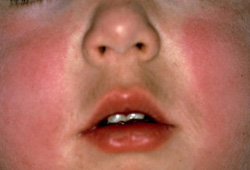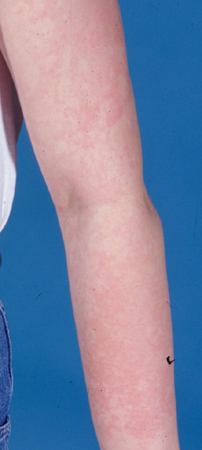History and exam
Key diagnostic factors
common
close contact with other infected individuals
Parvovirus B19 is spread via direct contact and respiratory droplets; close contact with infected individuals is a risk factor for the epidemics seen in late winter and early spring.[9]
bright red macular erythema of the bilateral cheeks with sparing of the nasal ridge and peri-oral areas
Initial presentation, resembling slapped cheeks. [Figure caption and citation for the preceding image starts]: Typical erythematous 'slapped cheeks' of erythema infectiosum.From the collection of Gary A. Dyer, MD; used with permission [Citation ends].
erythematous macules and papules evolving into lacy reticular erythema, most notable on the extremities
Macules and papules appear 1 to 4 days after initial facial rash.
Lacy reticular erythema lasts for 1 to 3 weeks although it may persist for longer.
The generalised exanthem may intensify with increased body temperature; parents should be cautioned that this does not reflect the recrudescence of the disease.
The exanthem is occasionally pruritic and is most common in paediatric patients.[2]
[Figure caption and citation for the preceding image starts]: Lacy, reticular, erythematous eruption of erythema infectiosum on an upper extremity.From the collection of Gary A. Dyer, MD; used with permission [Citation ends].
uncommon
immunodeficiency
This patient population includes patients with HIV, those receiving chemotherapy or immunosuppression following transplant, or patients with congenital immunodeficiencies.[2]
Persistent parvovirus B19 infection with resultant anaemia may occur.
Patients who are immunocompromised do not form immune complexes, so they do not present initially with classic erythema infectiosum.
Other diagnostic factors
common
arthralgia/arthritis
prodrome (fever, headache, pharyngitis, coryza, abdominal pain)
There have been a variety of mild prodromal symptoms reported.
These usually occur about 1 week after exposure and 1 to 2 weeks prior to onset of the exanthema.
Prodromal symptoms are more common in adults.
uncommon
symptoms of anaemia
Persistent parvovirus B19 infection (usually in individuals with immunosuppression) or infection in a patient with haemoglobinopathies and/or haemolytic anaemia can result in symptoms of severe anaemia such as fatigue, shortness of breath, tachycardia, pallor, and, light-headedness due to red cell aplasia.
Risk factors
strong
close contact with other infected individuals
Parvovirus B19 is spread via direct contact and respiratory droplets; close contact with infected individuals is a risk factor for the epidemics seen in late winter and early spring.[9]
weak
immunodeficiency
This patient population includes patients with HIV, those receiving chemotherapy or immunosuppression following transplant, or patients with congenital immunodeficiencies.[2]
Persistent parvovirus B19 infection with resultant anaemia may occur.
Patients who are immunocompromised do not form immune complexes, so they do not present initially with classic erythema infectiosum.
age 6 to 10 years
Parvovirus B19 can affect people of any age but is most common in children aged 6 to 10 years.[8]
Use of this content is subject to our disclaimer